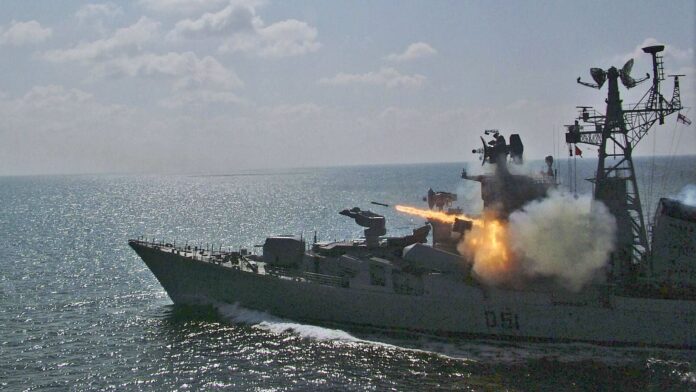INS Surat is the fourth and final Visakhapatnam-class destroyer built under Project 15B; INS Nilgiri is the lead ship of Project 17A, a class of seven multi-role frigates; and INS Vagsheer is the sixth and final Scorpene-class submarine built under Project 75.
The first two were designed at the Navy’s Directorate of Naval Design, but all three testify to India’s growing self-reliance in the critical domains of warship and submarine production.
In 1964, the Emergency Committee of the Cabinet laid down a target of a 140-warship navy. The more recent Maritime Capability Perspective Plan targets 160 ships.
Recent Navy chiefs have talked of a 200-ship force architecture, but have signalled that 175 warships would be more realistic. With about 140 functional warships today, India has some distance to go.
INS Surat: This will be the Navy’s 13th destroyer in service. Displacing 7,400 tonnes, it has sensors and weapons needed to tackle surface, air and underwater threats. Four Ukrainian Zorya gas turbines propel it at speeds of 60kmph.
After inducting five Kashin-class destroyers from the Soviet Union in the 1980s, India’s admirals were determined to design and build our own destroyers.
The first indigenous destroyers were three Delhi-class vessels—INS Delhi, INS Mysore and INS Mumbai—built under Project 15 at the turn of the century.
The Russian influence evident in Project 15 was replaced by a more Indian design in its successor class, Project 15A. Under this, three more destroyers were built at MDL: INS Kolkata, INS Kochiand and INS Chennai.
Next came the four Project 15B destroyers : INS Visakhapatnam, Mormugao, Imphal and Surat. Built at a combined cost of ₹35,800 crore, they are far more indigenized.
INS Surat will be succeeded by eight ‘next generation destroyers’ under Project 18. Displacing 13,500 tonnes and propelled by an “integrated electric propulsion,” these muscular warships will be the Navy’s future backbone.
Commodore Srikant Kesnur, a naval historian, describes the role of destroyers thus: “They can operate at the vanguard of the fleet with inbuilt flexibility in the manner of their deployment. They can be part of the ‘carrier task force’, or operate independently or in small groups, as ‘surface action groups’, or ‘search and attack units’.”
INS Nilgiri: India’s warship building story began in 1961 with the 120-tonne patrol vessel INS Ajay, built by Garden Reach Shipbuilders and Engineers. A decade later, MDL was building a line of six 2,700-tonne, Leander-class frigates with technology from the UK.
The lead ship of this class was INS Nilgiri, commissioned in 1972 and decommissioned in 1996. Now, INS Nilgiri will be reborn as the lead ship of Project 17A.
Built at a cost of ₹4,000 crore, INS Nilgiri features major advancements over the Shivalik-class frigates that preceded it. Seven Nilgiri-class vessels will be succeeded by Project 17B, featuring seven guided missile frigates, costing ₹10,000 crore each.
Both Nilgiri and Surat will carry the newly inducted Sikorsky MH-60R Seahawk, a versatile anti-submarine helicopter.
INS Vagsheer: The sixth and last Kalvari-class submarine that MDL has built under Project 75, this is one of the most silent and versatile diesel-electric submarines in the world.
It is designed for a range of missions, including anti-surface warfare, anti-submarine warfare, intelligence gathering, area surveillance and special operations.
Indian Navy submarines face an especially complex operating environment. Our coast is 7,500km long—5,600km on the peninsula plus 1,900km along island coasts.
The Arabian Sea’s shallow draft renders it suitable only for small conventional submarines. Meanwhile, the Bay of Bengal’s deep draft makes it ideal for large nuclear-powered submarines.
The commissioning of INS Vagsheer will enhance the number of Navy submarines to 17. These include seven Russian-origin Kilo-class, four German-origin HDW Type 209 submarines and six Scorpenes.
A year ago, India’s ministry of defence announced that the air-independent propulsion (AIP) developed by Defence Research and Development Organisation (DRDO) would be reverse-integrated into the fleet of six Scorpenes.
AIP multiplies a submarine’s operating endurance submerged. Conventional diesel-electric submarines must surface to charge their batteries after about 48 hours of operation. In contrast, AIP lets a submarine stay submerged for up to 14 days.
According to the ministry’s 30-year submarine building programme, Project 75 will be followed by Project 75-I, which involves building six AIP-propelled submarines in India with foreign AIP technology. However, with DRDO’s AIP making headway, it could power our Project 75-I boats.
Alongside the construction of 24 conventional submarines, DRDO is developing six nuclear propelled but conventionally armed attack submarines.
The commissioning of INS Nilgiri, Surat and Vagsheer demonstrates India’s progress in indigenous shipbuilding. These vessels have undergone rigorous trials on their machinery, hulls, fire-fighting equipment, plus damage-control assessments.
The vessels’ navigation and communication systems at sea have been tested too, making them fully operational and ready for deployment.
The author is a former colonel in the Indian Army.
#celebrate #warships #joining #Indias #naval #fleet
